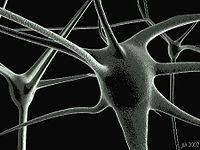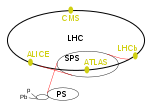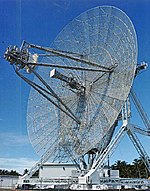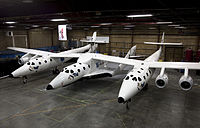Portal:Science/Featured article
| This page is currently inactive and is retained for historical reference. Article selection on the page Portal:Science has been automated via WP:RECOG. See Portal:Science/Recognized content. |
Usage
The layout design for these subpages is at Portal:Science/Featured article/Layout.
- Add a new Featured article to the next available subpage.
- Update "max=" to new total for its {{Random portal component}} on the main page.
Featured articles list
Featured article 1
Portal:Science/Featured article/1
Evolution is a change in the genetic makeup of a population within a species. Since the emergence of modern genetics in the 1940s, evolution has been defined more specifically as a change in the frequency of alleles from one generation to the next. The word "evolution" is often used as a shorthand for the modern theory of evolution of species based upon Charles Darwin's theory of natural selection, which states that all modern species are the products of an extensive process that began over three billion years ago with simple single-celled organisms, and Gregor Mendel's theory of genetics. As the theory of evolution by natural selection and genetics has become universally accepted in the scientific community, it has replaced other explanations including creationism and Lamarckism. Skeptics, often creationists, sometimes deride evolution as "just a theory" in an attempt to characterize it as an arbitrary choice and degrade its claims to truth. Such criticism overlooks the scientifically-accepted use of the word "theory" to mean a falsifiable and well-supported hypothesis.Featured article 2
Portal:Science/Featured article/2
A space elevator is a hypothetical structure designed to transport material from a planet's surface into space. Many different types of space elevator structures have been proposed. They all share the goal of replacing rocket propulsion with the traversal of a fixed structure via a mechanism not unlike an elevator, hence its name, in order to move material into or beyond orbit. Space elevators have also sometimes been referred to as space bridges, beanstalks, space ladders or space lifts. The most common proposal is a tether (usually a cable or ribbon) that spans from the surface to a point beyond geosynchronous orbit. As the planet rotates, the inertia at the end of the tether counteracts gravity and keeps the tether taut. Vehicles can then climb the tether and escape the planet's gravity without the use of rockets. Such a structure could eventually permit delivery of great quantities of cargo and people to orbit, and at costs only a fraction of those associated with current means.Featured article 3
Portal:Science/Featured article/3
New Horizons is a NASA uncrewed spacecraft designed to fly by Pluto and its moons (including Charon) and transmit images and data back to Earth. Mission planners hope that NASA will approve plans to continue the mission with a fly-by of a Kuiper Belt Object and return further data. A consortium of organizations, led by Southwest Research Institute and the Johns Hopkins Applied Physics Laboratory, has built the craft. The mission's principal investigator is S. Alan Stern of Southwest Research. The probe successfully launched from Cape Canaveral, Florida at 14:00 EST January 19, 2006 and flew past Jupiter on February 28, 2007 for a gravity assist.The primary scientific objectives are to characterize the global geology and morphology and map the surface composition of Pluto and Charon, and study the neutral atmosphere of Pluto and its escape rate. Other objectives include studying time variability of Pluto's surface and atmosphere; imaging and mapping areas of Pluto and Charon at high-resolution; characterizing Pluto's upper atmosphere, ionosphere, and energetic particle environment; searching for an atmosphere around Charon; refining bulk parameters of Pluto and Charon; and searching for additional satellites and rings.
Featured article 4
Portal:Science/Featured article/4
A quantum computer is any device for computation that makes direct use of distinctively quantum mechanical phenomena, such as superposition and entanglement, to perform operations on data. In a classical (or conventional) computer, the amount of data is measured by bits; in a quantum computer, it is measured by qubits. The basic principle of quantum computation is that the quantum properties of particles can be used to represent and structure data, and that devised quantum mechanisms can be used to perform operations with this data. For a generally accessible overview of quantum computing, see Quantum Computing with Molecules, an article in Scientific American by Neil Gershenfeld and Isaac L. Chuang.Experiments have already been carried out in which quantum computational operations were executed on a very small number of qubits. Research in practical areas continues at a frantic pace; see Quantum Information Science and Technology Roadmap for a sense of where the research is heading. Many national government and military funding agencies support quantum computing research, to develop quantum computers for both civilian and national security purposes, such as cryptanalysis.
Featured article 5
Portal:Science/Featured article/5
A quantum dot is a semiconducting crystal in nanotechnology. Quantum dots confine electrons, holes, electron-hole pairs, or excitons to zero dimensions in a region of the order of the electrons' Compton wavelength. This confinement leads to discrete quantized energy levels and to the quantization of charge in units of the elementary electric charge e. Quantum dots are particularly significant for optical applications due to their theoretically high quantum yield. Quantum dots have also been suggested as implementations of a qubit for quantum information processing.Because the quantum dot has discrete energy levels, much like an atom, they are sometimes called artificial atoms. The energy levels can be controlled by changing the size and shape of the quantum dot, and the depth of the potential. Like in atoms, the energy levels of small quantum dots can be probed by optical spectroscopy techniques. In contrast to atoms it is relatively easy to connect quantum dots by tunnel barriers to conducting leads, which allows the application of the techniques of tunneling spectroscopy for their investigation.
Featured article 6
Portal:Science/Featured article/6
Hydrogen chloride, also known under the name HCl, is a highly corrosive and toxic colorless gas that forms white fumes on contact with humidity. These fumes consist of hydrochloric acid which forms when hydrogen chloride dissolves in water. Hydrogen chloride gas as well as hydrochloric acid are important chemicals in chemistry, science, technology, and industry. The name HCl often refers somewhat misleadingly to hydrochloric acid instead of the gaseous hydrogen chloride.Hydrogen chloride forms corrosive hydrochloric acid on contact with body tissue. Inhalation of the fumes can cause coughing, choking, inflammation of the nose, throat, and upper respiratory tract, and in severe cases, pulmonary edema, circulatory system failure, and death. Skin contact can cause redness, pain, and severe skin burns. Hydrogen chloride may cause severe burns to the eye and permanent eye damage.
Featured article 7
Portal:Science/Featured article/7
Nanotechnology comprises technological developments on the nanometer scale, usually 1 to 100 nm (1/1,000 µm, or 1/1,000,000 mm). A possible way to interpret this size is to take the width of a human hair, and imagine something ten thousand times smaller. The term has sometimes been applied to microscopic technology.Nanotechnology is any technology which exploits phenomena and structures that can only occur at the nanometer scale, which is the scale of several atoms and small molecules. The United States's National Nanotechnology Initiative website defines nanotechnology as "the understanding and control of matter at dimensions of roughly 1 to 100 nanometers, where unique phenomena enable novel applications."
Featured article 8
Portal:Science/Featured article/8
Teflon is the brand name of the polymer polytetrafluoroethylene (PTFE) discovered by Roy J. Plunkett (1910–1994) of DuPont in 1938 and introduced as a commercial product in 1946. It is a fluoropolymer but not a thermoplastic in the true sense.PTFE has the lowest coefficient of friction of any known solid material. It is used as a non-stick coating for pans and other cookware. PTFE is very non-reactive and is often used in containers and pipework for reactive chemicals. Its melting point is 327°C, but its properties degrade above 260°C. At this point gaseous fluorine compounds are released that are dangerous to humans.
Other polymers with similar composition are known by the Teflon name: fluorinated ethylene-propylene (FEP) and perfluoroalkoxy polymer resin (PFA). They retain the useful properties of PTFE of low friction and non-reactivity, but are more easily formable. FEP is softer than PTFE and melts at 260°C; it is highly transparent and resistant to sunlight.
Featured article 9
Portal:Science/Featured article/9
Erosion is the displacement of solids (soil, mud, rock and other particles) by the agents of wind, water or ice, by downward or down-slope movement in response to gravity or by living organisms (in the case of bioerosion). Erosion is distinguished from weathering, which is the breaking down of rock and particles through processes where no movement is involved, although the two processes may be concurrent.Erosion is a natural process, but in many places it is increased by human land use. Poor land use practices include deforestation, overgrazing, unmanaged construction activity and road or trail building. However, improved land use practices can limit erosion, using techniques like terrace-building and tree planting.
A certain amount of erosion is natural and, in fact, healthy for the ecosystem. For example, gravels continually move downstream in watercourses. Excessive erosion, however, can cause problems, such as receiving water sedimentation, ecosystem damage (including fish kills) and outright loss of soil.
Featured article 10
Portal:Science/Featured article/10
A comet is a small body in the solar system that orbits the Sun and (at least occasionally) exhibits a coma (or atmosphere) and/or a tail — both due primarily to the effects of solar radiation upon the comet's nucleus, which itself is a minor planet composed of rock, dust, and ices. Due to their origins in the outer solar system and their propensity to be highly affected (or perturbed) by relatively close approaches to the major planets, comets' orbits are constantly changing. Some are moved into sungrazing orbits that destroy the comets when they are too near the Sun, while others are thrown out of the solar system forever.Most comets are believed to originate in a cloud (the Oort cloud) at large distances from the Sun consisting of debris left over from the condensation of the solar nebula; the outer edges of such nebulae are cool enough that water exists in a solid (rather than gaseous) state. Asteroids originate via a different process, but very old comets which have lost all their volatile materials may come to resemble asteroids.
Featured article 11
Portal:Science/Featured article/11
A mirror neuron is a neuron that fires both when an animal performs an action and when the animal observes the same action performed by another (especially conspecific) animal. Thus, the neuron "mirrors" the behavior of another animal, as though the observer were himself performing the action. These neurons have been observed in primates and in some birds. In humans, they have been found in Broca's area and the inferior parietal cortex of the brain. Some scientists consider mirror neurons one of the most important findings of neuroscience in the last decade. See for example, an essay by Ramachandran on their potential importance in imitation and language.In humans, mirror neurons are found in the inferior frontal cortex, close to Broca's area, a language region. This has led to suggestions that human language evolved from a gesture performance/understanding system implemented in mirror neurons. However, like many theories of language evolution, there is little direct evidence either way.
Featured article 12
Portal:Science/Featured article/12
Enzyme kinetics is the study of the rates of chemical reactions that are catalysed by enzymes. The study of an enzyme's kinetics provides insights into the catalytic mechanism of this enzyme, its role in metabolism, how its activity is controlled in the cell and how drugs and poisons can inhibit its activity.Enzymes are molecules that manipulate other molecules — the enzymes' substrates. These target molecules bind to an enzyme's active site and are transformed into products through a series of steps known as the enzymatic mechanism. Some enzymes bind multiple substrates and/or release multiple products, such as a protease cleaving one protein substrate into two polypeptide products. Others join substrates together, such as DNA polymerase linking a nucleotide to DNA. Although these mechanisms are often a complex series of steps, there is typically one rate-determining step that determines the overall kinetics. This rate-determining step may be a chemical reaction or a conformational change of the enzyme or substrates, such as those involved in the release of product(s) from the enzyme.
Featured article 13
Portal:Science/Featured article/13
An atomic line filter (ALF) is an advanced optical band-pass filter used in the physical sciences for filtering electromagnetic radiation with precision, accuracy, and minimal signal strength loss. Atomic line filters work via the absorption or resonance lines of atomic vapors and so may also be designated an atomic resonance filter (ARF).The three major types of atomic line filters are absorption-re-emission ALFs, Faraday filters and Voigt filters. Absorption-re-emission filters were the first type developed, and so are commonly called simply "atomic line filters"; the other two types are usually referred to specifically as "Faraday filters" or "Voigt filters". Atomic line filters use different mechanisms and designs for different applications, but the same basic strategy is always employed: by taking advantage of the narrow lines of absorption or resonance in a metallic vapor, a specific frequency of light bypasses a series of filters that block all other light.
Featured article 14
Portal:Science/Featured article/14
The geology of the Grand Canyon area exposes one of the most complete sequences of rock anywhere, representing a period of nearly 2 billion years of the Earth's history in that part of North America. The major sedimentary rock layers exposed in the Grand Canyon and in the Grand Canyon National Park area range in age from 200 million to nearly 2 billion years old. Most were deposited in warm, shallow seas and near ancient, long-gone sea shores. Both marine and terrestrial sediments are represented, including fossilized sand dunes from an extinct desert.Uplift of the region started about 75 million years ago in the Laramide orogeny, a mountain-building event that is largely responsible for creating the Rocky Mountains to the east. Accelerated uplift started 17 million years ago when the Colorado Plateaus (on which the area is located) were being formed. In total these layers were uplifted an estimated 10,000 feet (3000 m) which enabled the ancestral Colorado River to cut its channel into the four plateaus that constitute this area. But the canyon did not start to form until 5.3 million years ago when the Gulf of California opened up and thus lowered the river's base level (its lowest point) from that of large inland lakes to sea level.
Featured article 15
Portal:Science/Featured article/15
ATLAS (A Toroidal LHC ApparatuS) is one of the five particle detector experiments (ALICE, ATLAS, CMS, TOTEM, and LHCb) being constructed at the Large Hadron Collider, a new particle accelerator at CERN in Switzerland. It will be 45 metres long and 25 metres in diameter, and will weigh about 7,000 tonnes. The project involves roughly 2,000 scientists and engineers at 151 institutions in 34 countries. The construction was completed in 2008. The experiment is expected to measure phenomena that involve highly massive particles which were not measurable using earlier lower-energy accelerators and might shed light on new theories of particle physics beyond the Standard Model.The ATLAS collaboration, the group of physicists building the detector, was formed in 1992 when the proposed EAGLE (Experiment for Accurate Gamma, Lepton and Energy Measurements) and ASCOT (Apparatus with Super COnducting Toroids) collaborations merged their efforts into building a single, general-purpose particle detector for the Large Hadron Collider. The design was a combination of those two previous designs, as well as the detector research and development that had been done for the Superconducting Supercollider.
Featured article 16
Portal:Science/Featured article/16
DNA repair refers to a collection of processes by which a cell identifies and corrects damage to the DNA molecules that encode its genome. In human cells, both normal metabolic activities and environmental factors such as UV light can cause DNA damage, resulting in as many as 1 million individual molecular lesions per cell per day. Many of these lesions cause structural damage to the DNA molecule and can alter or eliminate the cell's ability to transcribe the gene that the affected DNA encodes. Other lesions induce potentially harmful mutations in the cell's genome, which affect the survival of its daughter cells after it undergoes mitosis. Consequently, the DNA repair process must be constantly active so it can respond rapidly to any damage in the DNA structure.The rate of DNA repair is dependent on many factors, including the cell type, the age of the cell, and the extracellular environment. A cell that has accumulated a large amount of DNA damage, or one that no longer effectively repairs damage incurred by its DNA, can enter one of three possible states: an irreversible state of dormancy, known as senescence; cell suicide, also known as apoptosis or programmed cell death; or unregulated cell division, which can lead to the formation of a tumor that is cancerous.
Featured article 17
Portal:Science/Featured article/17
RADAR is a system that uses radio waves to determine and map the location, direction, and/or speed of both moving and fixed objects such as aircraft, ships, motor vehicles, weather formations and terrain. A transmitter emits radio waves, which are reflected by the target and detected by a receiver, typically in the same location as the transmitter. Although the radio signal returned is usually very weak, radio signals can easily be amplified, so radar can detect objects at ranges where other emissions, such as sound or visible light, would be too weak to detect. Radar is used in many contexts, including meteorological detection of precipitation, air traffic control, police detection of speeding traffic, and by the military.The term RADAR was coined in 1941 as an acronym for Radio Detection and Ranging. This acronym of American origin replaced the previously used British abbreviation RDF (Radio Direction Finding). The term has since entered the English language as a standard word, radar, losing the capitalization in the process.
Featured article 18
Portal:Science/Featured article/18
Global warming is the observed increase in the average temperature of the Earth's atmosphere and oceans in recent decades.The Earth's average near-surface atmospheric temperature rose 0.6 ± 0.2 degree Celsius (1.1 ± 0.4 degree Fahrenheit) in the 20th century [1]. A widespread scientific opinion on climate change is that "most of the warming observed over the last 50 years is attributable to human activities"[2].
The increased amounts of carbon dioxide (CO2) and other greenhouse gases (GHGs) are the primary causes of the human-induced component of warming[3]. They are released by the burning of fossil fuels, land clearing and agriculture, etc. and lead to an increase in the greenhouse effect. The first speculation that a greenhouse effect might occur was by the Swedish chemist Svante Arrhenius in 1897, although it did not become a topic of popular debate until some 90 years later.
Featured article 19
Portal:Science/Featured article/19
Plate tectonics (from Greek τέκτων, tektōn "builder" or "mason") is a theory of geology which was developed to explain the observed evidence for large scale motions within the Earth's crust. The theory encompassed and superseded the older theory of continental drift from the first half of the 20th century and the concept of sea floor spreading developed during the 1960s.The outermost part of the Earth's interior is made up of two layers: above is the lithosphere, comprising the crust and the rigid uppermost part of the mantle. Below the lithosphere lies the asthenosphere, which is a more viscous zone of the mantle. Although solid, the asthenosphere has very low shear strength and can flow like a liquid on geological time scales. The deeper mantle below the asthenosphere is more rigid again.
Featured article 20
Portal:Science/Featured article/20
In physical cosmology, the Big Bang is the scientific theory that the universe emerged from a tremendously dense and hot state about 13.7 billion years ago. The theory is based on the observations indicating the expansion of space (in accord with the Robertson–Walker model of general relativity) as indicated by the Hubble redshift of distant galaxies taken together with the cosmological principle.Extrapolated into the past, these observations show that the universe has expanded from a state in which all the matter and energy in the universe was at an immense temperature and density. Physicists do not widely agree on what happened before this, although general relativity predicts a gravitational singularity (for reporting on some of the more notable speculation on this issue, see cosmogony).
The term Big Bang is used both in a narrow sense to refer to a point in time when the observed expansion of the universe (Hubble's law) began — calculated to be 13.7 billion (1.37 × 1010) years ago (±2%) — and in a more general sense to refer to the prevailing cosmological paradigm explaining the origin and expansion of the universe, as well as the composition of primordial matter through nucleosynthesis as predicted by the Alpher–Bethe–Gamow theory.
Featured article 21
Portal:Science/Featured article/21
Marine debris, also known as marine litter, is human-created waste that has deliberately or accidentally become afloat in a lake, sea, ocean or waterway. A form of water pollution, oceanic debris tends to accumulate at the centre of gyres and on coastlines. Some forms of marine debris, such as harmless driftwood, occur naturally, and human activities have been adding similar material into the oceans for thousands of years. Only recently, however, with the advent of plastic, has human influence become an issue as many types of plastics do not biodegrade. Waterborne plastic is both unsightly and dangerous; posing a serious threat to fish, seabirds, marine reptiles, and marine mammals, as well as to boats and coastal habitations. Ocean dumping, accidental container spillages, and wind-blown landfill waste are all contributing to this growing problem.Featured article 22
Portal:Science/Featured article/22
Scaled Composites' Model 339 SpaceShipTwo (SS2) is a suborbital spaceplane for carrying space tourists, under development by The Spaceship Company, a joint venture between Scaled Composites and Sir Richard Branson's Virgin Group, as part of the Tier 1b program. The spaceship was officially unveiled to the public on Monday, 7 December 2009, at the Mojave Air and Spaceport in California. The Virgin Galactic spaceline plans to operate a fleet of five of these craft in passenger-carrying private spaceflight service. The destruction in a test flight of the first craft in 2014 has delayed the start of commercial operations.Featured article 23
Portal:Science/Featured article/23
A laser is a device that emits light through a process of optical amplification based on the stimulated emission of electromagnetic radiation. The term "laser" originated as an acronym for "light amplification by stimulated emission of radiation". The first laser was built in 1960 by Theodore H. Maiman at Hughes Laboratories, based on theoretical work by Charles Hard Townes and Arthur Leonard Schawlow.A laser differs from other sources of light in that it emits light coherently. Spatial coherence allows a laser to be focused to a tight spot, enabling applications such as laser cutting and lithography. Spatial coherence also allows a laser beam to stay narrow over great distances (collimation), enabling applications such as laser pointers. Lasers can also have high temporal coherence, which allows them to emit light with a very narrow spectrum, i.e., they can emit a single color of light. Temporal coherence can be used to produce pulses of light as short as a femtosecond.
Nominations
Feel free to add featured science articles to the above list. You also may nominate them for inclusion here.























